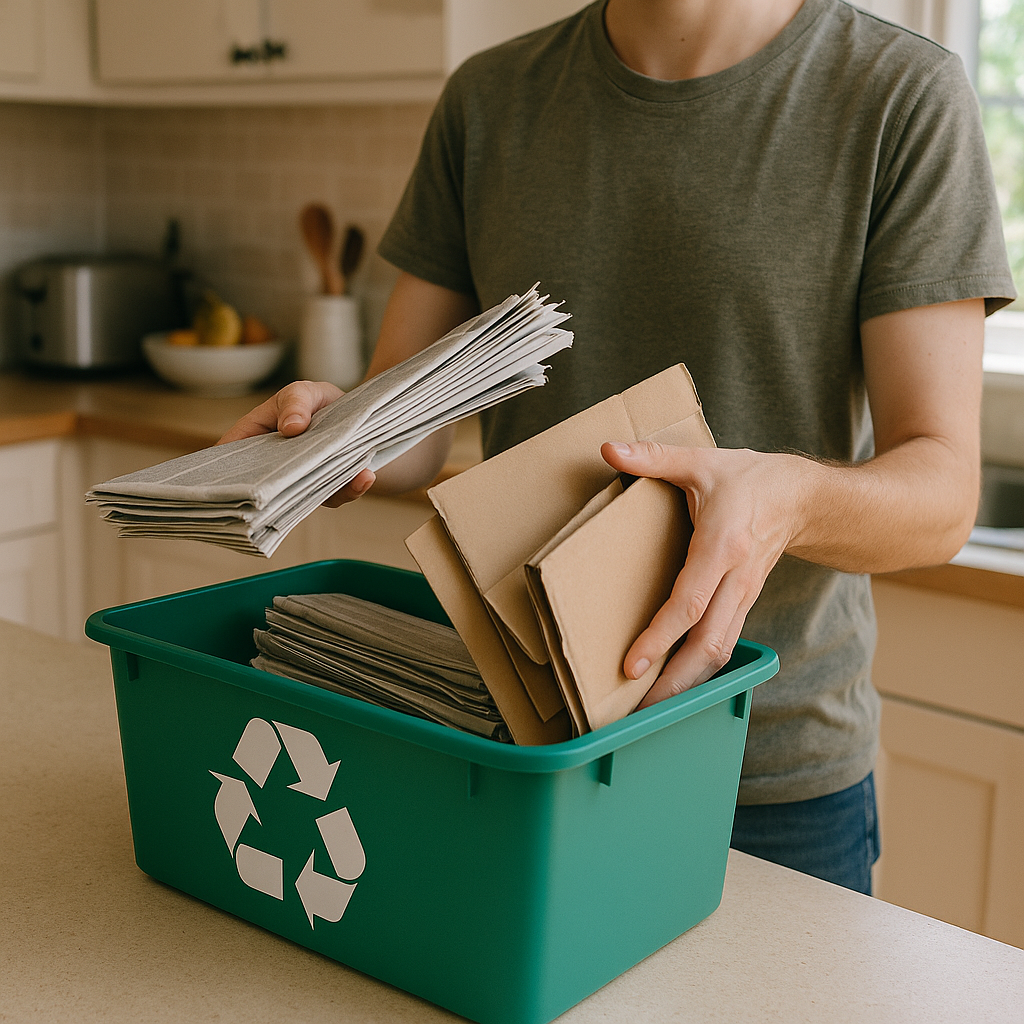5901 Botham Jean Blvd, Dallas, TX 75215
Recycling and Reusing: What Are Common Household Items You Can Recycle and Reuse?
August 31, 2025Did you know the average person creates almost five pounds of garbage daily? This amounts to over 1,600 pounds of waste per person each year. These figures highlight the increasing importance of recycling and reusing common household items.
Many everyday items can find new life through recycling or creative reuse. From the kitchen to the bathroom, opportunities to reduce waste exist throughout your home. Recycling benefits the planet by conserving valuable energy and protecting ecosystems from the harmful effects of waste.
Most people are familiar with recycling basics like paper, cardboard, and aluminum cans. However, many more household items can be diverted from landfills. Learning what can be recycled or repurposed is the first step toward a more sustainable lifestyle.
How Can You Recycle Paper and Cardboard Products?

Paper and cardboard products are among the most common waste materials in the United States, making up nearly a quarter of all municipal solid waste. Fortunately, these materials have high recycling rates, with over 68% of paper being recycled nationwide. Proper recycling of these items can significantly reduce landfill use and conserve natural resources.
Common Recyclable Paper Products
Most household paper items can be recycled through standard curbside programs. These typically include:
- Office paper and printer paper
- Newspapers and newspaper inserts
- Magazines and catalogs
- Brown paper bags
- Paperboard boxes (cereal boxes, pasta boxes, etc.)
- Corrugated cardboard boxes
- Paper mail and envelopes (remove plastic windows first)
The key to successful paper recycling is keeping materials clean and dry. When paper gets wet or contaminated with food, it generally can’t be recycled. This is why it’s important to store recyclable paper in a dry place and keep it separate from items that might leak or spill.
Preparing Cardboard for Recycling
Cardboard boxes need minimal preparation before recycling. Follow these steps to ensure they’re processed properly:
- Break down and flatten all boxes to save space
- Remove excessive tape and packing materials
- Keep cardboard dry until collection day
- Cut or fold larger boxes to fit in your recycling bin
Before recycling cardboard, consider whether it can be reused. Shipping boxes in good condition can often be repurposed for storage or offered to local businesses needing them for shipping.
The Pizza Box Dilemma
Pizza boxes present a common recycling challenge. Contrary to popular belief, pizza boxes with some grease stains can often be recycled. The key is separating greasy portions from clean ones:
- If only the bottom has grease stains, tear off the clean lid for recycling
- Remove any food remnants before recycling
- Pizza boxes with light oil stains are generally acceptable
- Heavily soiled or food-contaminated sections should be composted or discarded
Local recycling programs vary in their acceptance of pizza boxes. Some facilities have technology to handle light grease contamination, while others are more restrictive.
Books and Bound Materials
Books require special consideration before recycling:
- Hardcover books: Remove the hard cover before recycling the paper pages
- Paperback books: These can typically be recycled whole
- Books in good condition: Consider donating to libraries, schools, or charitable organizations before recycling
- Books with mold or water damage: These should be recycled rather than donated
Many communities have book recycling programs separate from regular paper recycling. Check with local libraries or recycling centers for book-specific options.
Items That Typically Can’t Be Recycled
Not all paper products are recyclable. These items generally don’t belong in your paper recycling bin:
- Shredded paper (fibers are too short; consider composting instead)
- Receipts (often coated with BPA)
- Waxed or plastic-coated paper (like most coffee cups)
- Paper towels, napkins, and tissues (can be composted)
- Gift wrap with metallic or shiny coating
- Butcher paper or freezer paper
- Paper contaminated with food or chemicals
Special Recycling Considerations
Some paper products require additional attention before recycling:
- Milk and juice cartons: These often contain plastic linings. Check if your facility accepts them.
- Paper bags with handles: Remove any rope or fabric handles before recycling.
- Padded envelopes: Separate paper exteriors from bubble wrap or fiber filling.
- Cardboard tubes: These can typically be recycled with other paper products.
Remember that cardboard can be recycled multiple times before the fibers become too weak, making it one of the most valuable materials in the recycling stream.
Local Guidelines Are Key
Recycling programs vary significantly between communities. Materials accepted in one area may be rejected in another. Before recycling paper and cardboard:
- Check your local waste management website for specific guidelines
- Look for recycling symbols and numbers on packaging
- Contact your waste hauler if you’re unsure about certain items
- Follow sorting instructions for your area’s collection system
| Recyclable Paper Products | Non-Recyclable Paper Products |
|---|---|
| Office paper and printer paper | Shredded paper |
| Newspapers and newspaper inserts | Receipts (coated with BPA) |
| Magazines and catalogs | Waxed or plastic-coated paper |
| Brown paper bags | Paper towels, napkins, and tissues |
| Paperboard boxes | Gift wrap with metallic or shiny coating |
| Corrugated cardboard boxes | Butcher paper or freezer paper |
| Paper mail and envelopes (plastic windows removed) | Paper contaminated with food or chemicals |
The environmental benefits of proper paper recycling are substantial. Each ton of recycled paper saves approximately 17 trees, 7,000 gallons of water, and reduces air pollution by 60 pounds. Taking the time to recycle paper products correctly makes a significant positive impact on our planet’s resources.
What Are Creative Ways to Reuse Glass and Plastic Containers?

Glass jars and plastic containers are versatile materials that can enjoy multiple lives before reaching recycling facilities. Repurposing these items not only reduces waste but also saves money while exercising your creativity. Let’s explore some practical ways to transform these everyday containers into useful household items.
Reusing Glass Jars
Glass jars offer durability and transparency, making them perfect for various applications around your home. Before reusing, ensure you clean them thoroughly by soaking in hot, soapy water to remove labels and adhesive residue.
For kitchen organization, glass jars excel at storing dry goods like grains, pasta, and spices. Their airtight seals keep food fresh while allowing you to see contents at a glance. You can also use them to store homemade sauces, fermented foods, or as containers for overnight oats and chia pudding breakfasts.
Beyond the kitchen, glass jars make excellent organizers. Use smaller jars to sort office supplies like paperclips and push pins. Larger jars can hold craft materials such as buttons, beads, or art supplies. Their transparency makes finding items effortless without opening multiple containers.
Glass jars also make stunning decorative pieces. Transform them into candle holders by adding a tea light or filling them with fairy lights for a gentle glow. For a simple DIY project, paint jars with chalk paint and add twine around the rim for a rustic look. You can also create terrariums by layering pebbles, soil, and small plants inside larger jars.
Repurposing Plastic Bottles
Plastic bottles can serve many functions beyond their original purpose. Start by thoroughly cleaning and drying the bottles before any project.
In the garden, plastic bottles become practical tools. Create a simple plant waterer by poking small holes in the cap, filling with water, and inserting upside down into the soil. For seedling planters, cut bottles horizontally, use the bottom half for planting, and the top half as a mini greenhouse cover.
Bird feeders are another popular use for plastic bottles. Cut small openings in the sides of a bottle, insert wooden spoons or dowels through opposite sides to create perches, and fill with bird seed. The spoons also serve as feeding platforms for your feathered visitors.
Larger plastic containers can be repurposed for rainwater collection. Simply position them under downspouts to capture rainwater for garden use. This not only reduces water consumption but also provides chemical-free water for sensitive plants.
Transforming Takeout Containers
Plastic takeout containers often come in standard sizes with secure lids, making them perfect for organization projects. After thorough cleaning, these containers can store leftovers, but they’re also valuable throughout your home.
In craft rooms, takeout containers efficiently organize small items like buttons, beads, and sewing notions. Their stackable design maximizes storage space. For small hardware like nails, screws, and picture hangers, these containers keep items visible yet contained.
Takeout containers also make excellent seed-starting trays. Poke drainage holes in the bottom, fill with seed-starting mix, and you have an instant mini greenhouse when the lid is closed.
How to Prepare Containers for Reuse
Proper cleaning is essential before repurposing any container, especially for food storage. For stubborn labels on glass, try soaking in warm water with baking soda or applying a small amount of cooking oil to dissolve adhesive.
For plastic containers, ensure they’re food-safe by checking the recycling code on the bottom. Numbers 1, 2, 4, and 5 are generally considered safer for food storage. Always avoid using containers that previously held non-food items for storing edibles.
Remember that while reusing containers is environmentally beneficial, not all containers should be reused indefinitely. When plastic shows signs of wear—becoming cloudy, scratched, or warped—it’s time to recycle and replace.
By incorporating these creative reuse ideas into your routine, you’ll extend the life of everyday containers while reducing waste and discovering new ways to organize and beautify your space. The versatility of these simple items proves that sustainability and practicality can go hand in hand.
| Container Type | Reuse Application |
| Small airtight containers | Store snacks like nuts, fruits, or chips |
| Travel-sized plastic containers | Store shampoos, lotions, or other toiletries |
| Large plastic containers | Organize car items like wipes, tissues, etc. |
| Glass jars | Store grains, pasta, and spices in the kitchen |
| Plastic bottles | Create plant waterers or bird feeders |
| Takeout containers | Organize craft supplies or hardware |
Final Words

Recycling and reusing everyday household materials significantly reduce waste, conserve resources, and save money. Whether it’s properly preparing paper and cardboard for recycling, creatively repurposing glass jars, or transforming plastic containers into practical storage solutions, each effort reduces environmental strain. By making conscious choices, you’re not only preventing items from ending up in landfills but also giving them new life with meaningful purpose.
Small changes in how we manage common household items can have a substantial impact over time. Consistent recycling and creative reuse allow us all to contribute to a cleaner, more sustainable future for our homes and communities.
Interested in further reducing waste? Call Okon Recycling today at 214-717-4083 for all your recycling needs.
